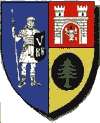Vințu de Jos
Vințu de Jos, also known as Vinț (German: Unter-Wintz, Winzendorf, Alvinz, Weinsdorf; Hungarian: Alvinc; Latin: Binstum; Turkish: Aşağı Vinçazvar), is a commune located in the centre of Alba County, Transylvania, Romania. It is composed of eighteen villages: Câmpu Goblii (Unter-Eisenberg; Telekvinc), Ciocașu (Zoggesch; Csókás), Crișeni (Krieschen), Dealu Ferului (Eisenberg; Vashegy), Gura Cuțului (Gurrenkutz), Hațegana (Hetzingen), Inuri (Lilienfeld; Borsómező), Laz (Slawendorf), Mătăcina (Mattatschin), Mereteu (Merethof; Merítő), Pârău lui Mihai (Michelsdorf), Poienița (Pojenitz), Stăuini (Stabing), Valea Goblii (Goblsdorf; Goblipatak), Valea lui Mihai (Michaelsdorf), Valea Vințului (Wintzbach; Valye Vinci), Vințu de Jos and Vurpăr (Burgberg-Walbersdorf; Borberek).
Vințu de Jos | |
|---|---|
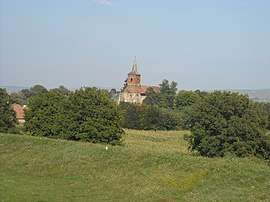 Reformed church in Vințu de Jos | |
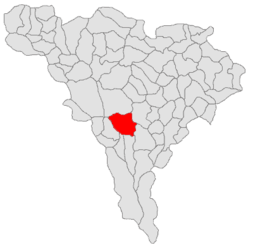 Location in Alba County | |
 Vințu de Jos Location in Romania | |
| Coordinates: 45°59′N 23°30′E | |
| Country | |
| County | Alba |
| Government | |
| • Mayor | Ion Iosif Josan |
| Area | 85.27 km2 (32.92 sq mi) |
| Population (2011)[1] | 4,801 |
| • Density | 56/km2 (150/sq mi) |
| Time zone | EET/EEST (UTC+2/+3) |
| Vehicle reg. | AB |
| Website | https://vintudejos.ro |
Geography
Vințu de Jos has a surface of 8,527 hectares and is located on the Mureş River, in the centre of Alba County, approximately 10 km from the city of Sebeș on the Romanian National Road DN7, and 15 km from the county capital, Alba Iulia on the Romanian County Road 107C and the Romanian National Road DN1.[2]
The commune is bordered by the city of Alba Iulia in the north-east, the city of Sebeș in the south-east, the communes of Pianu and Săliștea in the south, and the commune of Blandiana in the west.[2]
Economy
The centre of the commune, Vințu de Jos, has a large train station and houses a shoe factory. The train station is an important connection station that links the CFR-Romanian Railways main lines 200 and 300 via the line 200A. It is also on the route of the original Orient Express.[2]
Demographics
The 2002 census recorded 5,295 people living at the time in the commune, of which 5,108 (96.5%) Romanians, 90 (1.7%) Roma, 76 (1.4%) Hungarians and 8 (0.2%) Germans.[3]
Tourist attractions
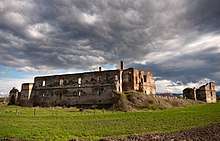
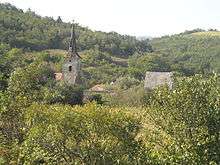
Vințu de Jos' tourist objectives include:[2]
- The Martinuzzi Castle – the ruins of the Renaissance castle where George Martinuzzi was assassinated in 1551.
- The ruins of a former Dominican monastery.
- The ruin of the fortified church of Vurpăr.
- The Monument of Romanian Heroes from World War I, built in 1920.
Natives
- Joseph Alvinczy (1735–1810)
- János Csató (1833–1913)
- Zsigmond Kemény (1814–1875)
- István Pongrácz (1584–1619)
References
- "Populaţia stabilă pe judeţe, municipii, oraşe şi localităti componenete la RPL_2011" (in Romanian). National Institute of Statistics. Retrieved 4 February 2014.
- "Descoperă comuna noastră!". vintudejos.ro (in Romanian). Retrieved May 23, 2020.
- (in Romanian) "Vințu de Jos", at the Erdélyi Magyar Adatbank's Recensământ 2002; Retrieved on April 16, 2016.
External links
| Wikimedia Commons has media related to Vințu de Jos, Alba. |
- "Vințu de Jos Archaeological Site" (in Romanian).
